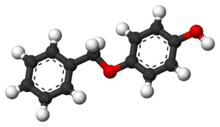Monobenzone
 | |
 | |
| Clinical data | |
|---|---|
| AHFS/Drugs.com | International Drug Names |
| Routes of administration | Topical |
| ATC code | D11AX13 (WHO) |
| Legal status | |
| Legal status |
|
| Identifiers | |
| |
| Synonyms | Hydroquinone benzyl ether, Hydroquinone monobenzyl ether, Benzyl p-hydroxyphenyl ether, Benzyl hydroquinone, Benzoquin, 4-(phenylmethoxy)phenol |
| CAS Number |
103-16-2 |
| PubChem (CID) | 7638 |
| IUPHAR/BPS | 6830 |
| DrugBank |
DB00600 |
| ChemSpider |
7356 |
| UNII |
9L2KA76MG5 |
| KEGG |
D05072 |
| ChEMBL |
CHEMBL1388 |
| ECHA InfoCard | 100.002.804 |
| Chemical and physical data | |
| Formula | C13H12O2 |
| Molar mass | 200.233180 g/mol |
| | |
Monobenzone, also called 4-(Benzyloxy)phenol and monobenzyl ether of hydroquinone (MBEH) is an organic chemical in the phenol family with chemical formula C6H5CH2OC6H4OH.[1][2] It is used as a topical drug for medical depigmentation.[3][4] It is a colourless solid that is classified as the monobenzyl ether of hydroquinone. Monobenzone is soluble in alcohol, benzene, and diethyl ether, and practically insoluble in water.
Pharmacology
The topical application of monobenzone in animals increases the excretion of melanin from melanocytes. The same action is thought to be responsible for the depigmenting effect of the drug in humans. Monobenzone may cause destruction of melanocytes and permanent depigmentation.
The histology of the skin after depigmentation with topical monobenzone is the same as that seen in vitiligo; the epidermis is normal except for the absence of identifiable melanocytes. Therefore, monobenzone is used as a topical medicine to permanently depigment normal skin surrounding vitiliginous lesions only in patients with disseminated (greater than 50 percent of body surface area) idiopathic vitiligo.Monobenzone is also being considered for the treatment of Melanoma.[5]
Other uses
Monobenzone is also used to derive dyes for fiber dyeing and is used in the rubber industry.
See also
References
- ↑ "4-(Benzyloxy)phenol - Substance Summary". Retrieved 9 September 2013.
- ↑ "4-(Benzyloxy)phenol, 98%". ChemExper. Retrieved 9 September 2013.
- ↑ http://www.emedicinehealth.com/drug-monobenzone_topical/article_em.htm
- ↑ Skin bleaching with monobenzone
- ↑ "Monobenzone as Immunotherapy for Melanoma". jwatch. Retrieved 2012-06-26.
Further reading
- Bolognia, J. L., Lapia, K. and Somma, S. (2001), Depigmentation therapy. Dermatologic Therapy, 14: 29–34. doi:10.1046/j.1529-8019.2001.014001029.x